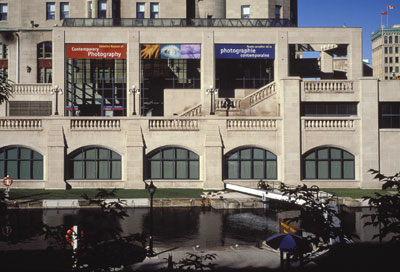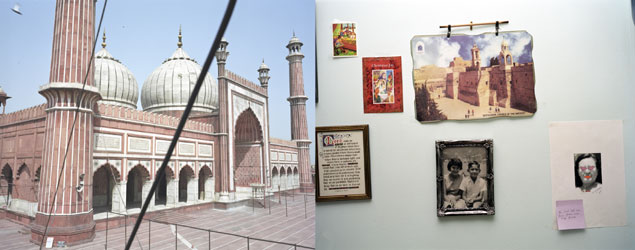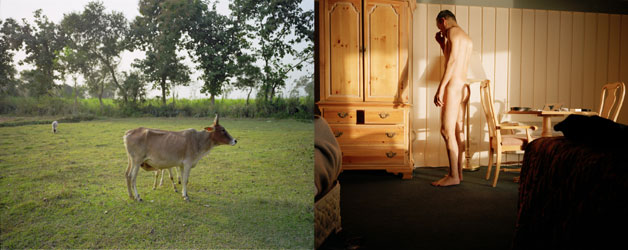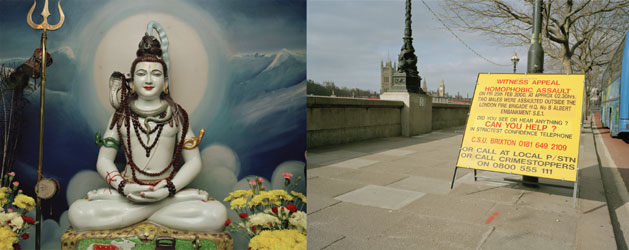|
February 14, 2006
Hello from Ottawa: The Canadian Museum of
Contemporary Photography featuring Sunil Gupta and the Challenges
of Immigration
My schedule in Ottawa this past weekend was extremely compressed,
but there was one place I wasn’t going to miss: the Canadian
Museum of Contemporary Photography. As a person with no formal
background, yet a keen interest in the visual arts and photography,
I have been wanting to visit this museum for a long time. And my
Internet research revealed that the Museum is featuring a very special
exhibition right now: two photographic series by Sunil Gupta, an
Indian-born Canadian citizen, exploring issues of identity, culture
and the immigrant experience.

The Canadian Museum of Contemporary Photography
Let me start first with the Museum itself, a rather unique venue
in Ottawa with a long history. The Canadian Museum of Contemporary
Photography began its life all the way back in World War II as the
Still Photography Museum of the National Film Board. Its activities
include collecting, publishing and organizing traveling exhibitions
and educational programs to foster the efforts and development of
Canadian photographers.
It’s a unique place in a unique venue: the Museum is housed
in a former railroad tunnel of the Grand Trunk Railroad. It is accessible
through an above-ground entrance immediately west of the Fairmont
Chateau Laurier Hotel in downtown Ottawa, and an elevator takes
you 2 storeys down from street level. As a former railroad tunnel,
the Museum's unique dimensions won’t come as a surprise: it
measures 166 meters (545 feet) in length by only 17 meters (56 feet)
in width. The facility is more like a 32-storey high-rise building
laid on its side.
Even constructing the Museum entailed significant engineering challenges:
due to the narrowness of the site, squeezed in between the Chateau
Laurier on one side and the Rideau Canal on the other, construction
trucks had to back into the site, edging their way half a mile along
a road carved in the limestone and shale cliff face.

The Canadian Museum of Contemporary Photography
But I wasn’t only there to explore the unique architectural
features of the gallery. The main reason for my visit was an exhibition
by Sunil Gupta, whose 2 collections shed light
on the immigrant experience.
Sunil Gupta was born in New Delhi in 1953 and came to Montreal
with his parents at age 15. Over the years he has also lived in
New York City and London and just recently moved back to India.
Originally he studied accounting, but later moved into visual arts
and photography.
Until April 23, 2006, the Museum features two highly personal collections
by this artist. Social Security (1988) features
Sunil Gupta’s family photographs and his mother’s words
to shed light on the story of one immigrant family in Montreal.
His family came from a middle-class background in India, and after
their move to Canada they had significant adjustment problems. Sunil’s
father was forced to work as a security guard and the family experienced
a loss of financial security and social status. This was complicated
by the fact that his parents were already in their fifties by the
time of the move which made integration into Canadian culture even
more difficult.

Sunil Gupta
Jama Masjid, Delhi /
Blvd. René Levesque O., Montreal
From the series Homelands 2001-2003
Ink jet print, 76.2 x 149.9 cm
Courtesy of the artist
© Sunil Gupta
This photo collection illustrates the fact that his parents had
traditional desires for both Sunil and his sister, and neither of
the two children fulfilled the role expectations put upon them by
their Indian parents. Sunil’s sister ended up marrying an
American, something the parents did not support. Sunil himself is
actually gay and had several long-term relationships with men, much
to the chagrin of his parents. Neither offspring fulfilled the role
of marrying an Indian spouse and creating a traditional Indian family.
As such, the move to Canada was a big disappointment, particularly
for Sunil’s father.
Incidentally Sunil’s father died of a heart attack on a Montreal street in 1986. He wasn’t found until several days later.
One particularly gripping photograph shows Sunil’s father’s
belongings, money, identification, credit cards, that were removed
from his body after his death. It took the authorities three days
to notify the family, presumably because his father was assigned
to the “immigrant” section of the morgue. Nobody had
bothered to check his identification and call his family, even though
his father had all the necessary papers on him. And his social security
card had been neatly cut in half.
Sunil Gupta’s second photo collection Homelands
(2001 to 2003) includes large-scale diptychs that
juxtapose images from his experience in the West with images from
his home country in India. His exhibition explores highly personal
topics, such as Gupta’s homosexuality and the fact that he
is HIV positive. Gupta was diagnosed with HIV in 1995.

Sunil Gupta
Mundia Pamar, Uttar Pradesh /
Chesapeake Bay, Maryland
From the series Homelands 2001-2003
Ink jet print, 76.2 x 149.9 cm
Courtesy of the artist
© Sunil Gupta
For me the most powerful image of the collection includes Gupta
in front of a mirror, stark naked, facing the camera, with a sliver
of his mirror image showing right next to an image of India. My
museum guide indicated that Sunil has actually commented that he
lives right in that narrow line between East and West.
It seems that his cultural identity is tenuous at best and Sunil
decided recently to move back to India to explore his own cultural
background. It is significant to mention that India does not accept
homosexuality, does not offer treatment required for AIDS patients
and doesn’t even officially acknowledge the existence of the
disease. In addition India harbours a host of dangerous viruses
that pose a constant threat to Sunil’s health. Even beyond
that Sunil indicated that he lives in constant fear that his medical
condition will be discovered and that he will be deported from India.
Both of Sunil Gupta’s series of photographs are highly personal,
where he exposes himself (literally), his family members and the
dynamics of an immigrant family in North America. His images use
colour, atmospheric influences and juxtaposition to express symbolism
and speak of an ongoing struggle to find his own personal, sexual
and cultural identity at the confluence of Eastern and Western cultures.

Sunil Gupta
Queens, New York / Lambeth, London
From the series Homelands 2001-2003
Ink jet print, 76.2 x 149.9 cm
Courtesy of the artist
© Sunil Gupta
For me personally, Sunil Gupta’s autobiographical photographs
were almost shocking in their candor and openness. They talk about
the cultural pressures and expectations that face second generation
immigrants growing up in a liberal Western environment. Juxtaposed
to this external environment is their traditional Eastern family
milieu with its strict rules and role expectations, almost imposing
a schizophrenic existence on their offspring.
It was rather surprising to me that Sunil Gupta decided recently
to move back to a country where, as a gay HIV-positive individual,
he is not accepted and it speaks to his overwhelming urge to reconnect
with his roots.
The Canadian Museum of Photography is currently also hosting another
installation: Imprints: Photographs by Michel Campeau, Marlene
Creates, Lorraine Gilbert, Sarah Anne Johnson, and Sylvie Readmen
features 19 recent acquisitions that explore nature and its forces
as they intersect with the human world.
Related Articles:
Hello from Ottawa
- My 2-day packed itinerary for Winterlude
Hello from Ottawa - First
impressions and an overview
Hello from Ottawa - The Lord Elgin
Hotel: a historic landmark in the heart of Ottawa
Hello from Ottawa - Fat Tuesday's
and the Mardi Gras Experience in the ByWard Market
Hello from Ottawa - An early
morning walk to Parliament Hill
Hello from Ottawa - Skating
on the Rideau Canal, the World's Largest Skating Rink
Hello from Ottawa - Charity and
hilarity: the 26th Annual Bedzz Races on Dow's Lake
Hello from Ottawa - Confederation
Park and other Winterlude locations
Hello from Ottawa - Darcy McGee's:
a historic Irish pub on Sparks Street
Hello from Ottawa - The Canadian
War Museum and "Weapons of Mass Dissemination - The Propaganda
of War"
Hello from Ottawa - The
Canadian Museum of Contemporary Photography featuring Sunil Gupta
and the challenges of immigration
An interview with Tourism Ottawa
provides a great overview of this city
An interview about
the ByWard Market, a prime entertainment and shopping area
An interview
with the National Gallery of Canada
An interview
with the Canadian Museum of Civilization
Helpful websites:
Ottawa
Tourism: Ottawa's official tourism information
The ByWard
Market Business Improvement Area
The
National Capital Commission
The National
Museum of Civilization
The National Gallery
of Canada
The Canadian War
Museum
Useful books about Ottawa:
|